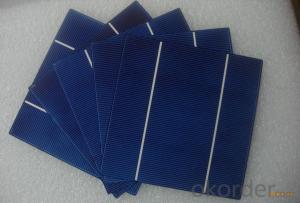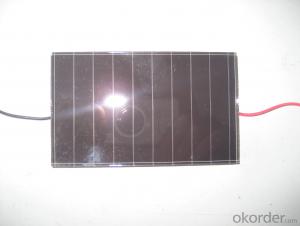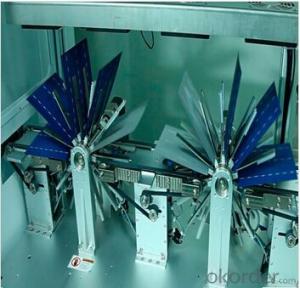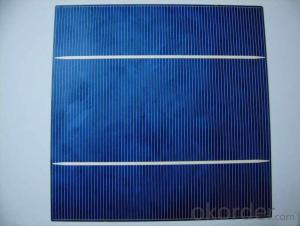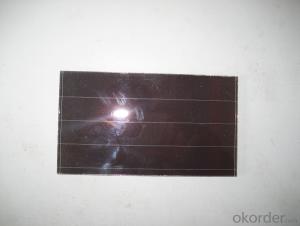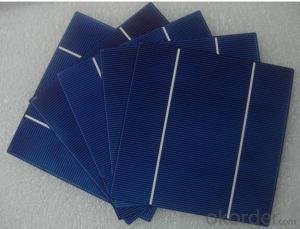Solar Cell High Quality A Grade Cell Polyrystalline 5v 17.4%
- Loading Port:
- Shanghai
- Payment Terms:
- TT OR LC
- Min Order Qty:
- 1000 pc
- Supply Capability:
- 100000 pc/month
OKorder Service Pledge
OKorder Financial Service
You Might Also Like
Specifications
hot sale solar cell
1.16.8%~18.25% high efficiency
2.100% checked quality
3.ISO9001/ISO14001/TUV/CE/UL
4.stable performance
We can offer you the best quality products and services, don't miss !
POLY6'(156*156)
Polycrystalline Silicon Solar cell
Physical Characteristics
Dimension: 156mm×156mm±0.5mm
Diagonal: 220mm±0.5mm
Thickness(Si): 200±20 μm
Front(-) Back(+)
Blue anti-reflecting coating (silicon nitride); Aluminum back surface field;
1.5mm wide bus bars; 2.0mm wide soldering pads;
Distance between bus bars: 51mm . Distance between bus bars :51mm .
Electrical Characteristics
Efficiency(%) | 18.00 | 17.80 | 17.60 | 17.40 | 17.20 | 16.80 | 16.60 | 16.40 | 16.20 | 16.00 | 15.80 | 15.60 |
Pmpp(W) | 4.33 | 4.29 | 4.24 | 4.19 | 4.14 | 4.09 | 4.04 | 3.99 | 3.94 | 3.90 | 3.86 | 3.82 |
Umpp(V) | 0.530 | 0.527 | 0.524 | 0.521 | 0.518 | 0.516 | 0.514 | 0.511 | 0.509 | 0.506 | 0.503 | 0.501 |
Impp(A) | 8.159 | 8.126 | 8.081 | 8.035 | 7.990 | 7.938 | 7.876 | 7.813 | 7.754 | 7.698 | 7.642 | 7.586 |
Uoc(V) | 0.633 | 0.631 | 0.628 | 0.625 | 0.623 | 0.620 | 0.618 | 0.617 | 0.615 | 0.613 | 0.611 | 0.609 |
Isc(A) | 8.709 | 8.677 | 8.629 | 8.578 | 8.531 | 8.478 | 8.419 | 8.356 | 8.289 | 8.220 | 8.151 | 8.083 |
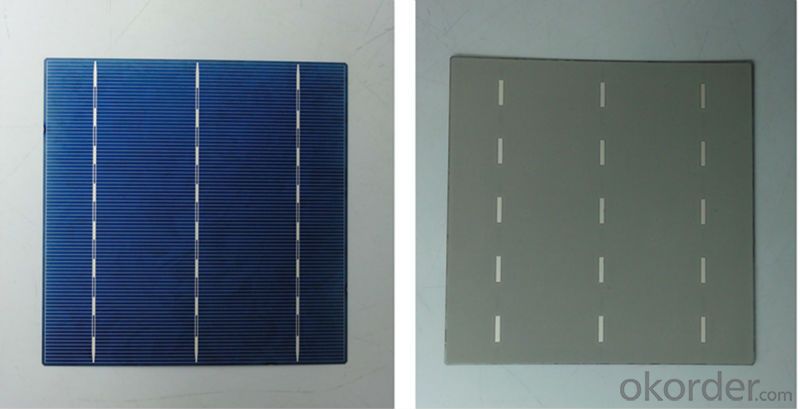
MONO5'(125*125mm)165
Monocrystalline silicon solar cell
Physical Characteristics
Dimension: 125mm×125mm±0.5mm
Diagonal: 165mm±0.5mm
Thickness(Si): 200±20 μm
Front(-) Back(+)
Blue anti-reflecting coating(silicon nitride); Aluminum back surface field;
1.6mmwide bus bars; 2.5mm wide soldering pads;
Distance between bus bars: 61mm . Distance between bus bars :61mm .
Electrical Characteristics
Efficiency(%) | 19.40 | 19.20 | 19.00 | 18.80 | 18.60 | 18.40 | 18.20 | 18.00 | 17.80 | 17.60 | 17.40 | 17.20 |
Pmpp(W) | 2.97 | 2.94 | 2.91 | 2.88 | 2.85 | 2.82 | 2.79 | 2.76 | 2.73 | 2.70 | 2.67 | 2.62 |
Umpp(V) | 0.537 | 0.535 | 0.533 | 0.531 | 0.527 | 0.524 | 0.521 | 0.518 | 0.516 | 0.515 | 0.513 | 0.509 |
Impp(A) | 5.531 | 5.495 | 5.460 | 5.424 | 5.408 | 5.382 | 5.355 | 5.328 | 5.291 | 5.243 | 5.195 | 4.147 |
Uoc(V) | 0.637 | 0.637 | 0.636 | 0.635 | 0.633 | 0.630 | 0.629 | 0.629 | 0.628 | 0.626 | 0.626 | 0.625 |
Isc(A) | 5.888 | 5.876 | 5.862 | 5.848 | 5.839 | 5.826 | 5.809 | 5.791 | 5.779 | 5.756 | 5.293 | 5.144 |

FAQ:
Q:How can i get some sample?
A:Yes , if you want order ,sample is not a problem.
Q:How about your solar panel efficency?
A: Our product efficency around 17.25%~18.25%.
Q:What’s the certificate you have got?
A: we have overall product certificate of ISO9001/ISO14001/CE/TUV/UL
- Q:How do solar silicon wafers perform in hot climates?
- Solar silicon wafers perform well in hot climates due to their ability to withstand high temperatures. The efficiency of solar panels made from these wafers may decrease slightly in extremely hot conditions, but their overall performance remains reliable and efficient in converting sunlight into electricity.
- Q:Can solar silicon wafers be used in solar-powered street lighting systems?
- Yes, solar silicon wafers can be used in solar-powered street lighting systems. The silicon wafers are typically used in photovoltaic cells, which convert sunlight into electricity. These cells can be integrated into solar panels that power street lights, providing a sustainable and renewable source of energy.
- Q:What is the expected cost reduction for solar silicon wafers in the future?
- The expected cost reduction for solar silicon wafers in the future is projected to be significant due to advancements in manufacturing technology, economies of scale, and increasing competition in the solar industry. As more companies invest in research and development, the cost of producing silicon wafers is expected to decrease, making solar energy more affordable and accessible to a wider range of consumers. However, the exact percentage of cost reduction is difficult to determine as it depends on various factors such as market demand, government policies, and technological breakthroughs.
- Q:How thick is a solar silicon wafer?
- A solar silicon wafer is typically about 200 to 300 micrometers thick.
- Q:What is the effect of surface roughness on the performance of solar silicon wafers?
- The effect of surface roughness on the performance of solar silicon wafers can be significant. A smooth surface allows for better light absorption and reduced reflection, leading to higher efficiency in converting sunlight into electricity. In contrast, high surface roughness can scatter and reflect light, resulting in lower energy conversion efficiency. Additionally, rough surfaces may increase the chances of recombination and trapping of charge carriers, further reducing overall performance. Therefore, maintaining a low surface roughness is crucial for maximizing the efficiency and performance of solar silicon wafers.
- Q:How do solar silicon wafers handle extreme temperatures?
- Solar silicon wafers are designed to handle extreme temperatures quite well. They typically have a high melting point and can withstand temperatures ranging from extremely cold to very hot without significant damage. This is due to the high purity and crystalline structure of the silicon material used in their construction. Additionally, solar panels are often equipped with thermal management systems to dissipate excess heat and prevent any adverse effects on the wafers. Overall, solar silicon wafers are engineered to endure extreme temperature conditions and maintain their efficiency and reliability in various climates.
- Q:How do solar silicon wafers contribute to reducing dependence on fossil fuels?
- Solar silicon wafers contribute to reducing dependence on fossil fuels by being the key component in solar cells. These wafers, made from purified silicon, absorb sunlight and convert it into electricity through the photovoltaic effect. By harnessing solar energy, we can generate clean and renewable electricity, reducing the need for fossil fuels that contribute to greenhouse gas emissions and climate change.
- Q:What are the main defects in solar silicon wafers?
- The main defects in solar silicon wafers can include impurities, such as iron or boron, which can reduce the efficiency of the solar cells. Other defects may include cracks, dislocations, or grain boundaries, which can affect the structural integrity and electrical performance of the wafers.
- Q:What is the impact of wafer resistivity on solar silicon wafer performance?
- The wafer resistivity of a solar silicon wafer has a significant impact on its performance. Lower resistivity wafers have higher conductivity, allowing for more efficient flow of electrical current. This leads to improved conversion of sunlight into electricity and higher overall solar cell efficiency. On the other hand, higher resistivity wafers may result in increased resistive losses, reducing the effectiveness of the solar cell. Therefore, selecting silicon wafers with appropriate resistivity is crucial in optimizing solar panel performance.
- Q:What are the different types of junctions formed on solar silicon wafers?
- The different types of junctions formed on solar silicon wafers include p-n junctions, heterojunctions, and back surface field junctions.
1. Manufacturer Overview |
|
|---|---|
| Location | |
| Year Established | |
| Annual Output Value | |
| Main Markets | |
| Company Certifications | |
2. Manufacturer Certificates |
|
|---|---|
| a) Certification Name | |
| Range | |
| Reference | |
| Validity Period | |
3. Manufacturer Capability |
|
|---|---|
| a)Trade Capacity | |
| Nearest Port | |
| Export Percentage | |
| No.of Employees in Trade Department | |
| Language Spoken: | |
| b)Factory Information | |
| Factory Size: | |
| No. of Production Lines | |
| Contract Manufacturing | |
| Product Price Range | |
Send your message to us
Solar Cell High Quality A Grade Cell Polyrystalline 5v 17.4%
- Loading Port:
- Shanghai
- Payment Terms:
- TT OR LC
- Min Order Qty:
- 1000 pc
- Supply Capability:
- 100000 pc/month
OKorder Service Pledge
OKorder Financial Service
Similar products
New products
Hot products
Related keywords
